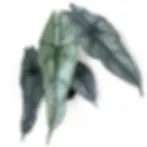All About the Dragons: A Complete Guide to Dragon-Named Alocasias
- Foliage Factory
- 4 days ago
- 21 min read
Dragon Alocasias – Why These Jewel Plants Rule Modern Collections
Thick, quilted leaves that look like armor. Metallic overlays that shimmer like dragon scales. No wonder Dragon Alocasias have become some of the most coveted plants among collectors. Of course there’s no official botanical group called “Dragon Alocasias.” The term exists purely in the trade to describe cultivars and hybrids with dragon-like textures and colors—most derived from species like Alocasia baginda, melo, and reginula.
In this guide we will do our best to bring you some clarity. It explains the wild species behind these plants, how selective breeding shaped today’s cultivars, and what traits make each hybrid unique. Our goal is to help you compare Dragons side by side, understand their care needs, and avoid common naming pitfalls.
What This Guide Covers
The wild species behind every Dragon Alocasia and how their native habitat influences indoor care
Key differences between core cultivars and advanced hybrids like Dragon Moon and Black Dragon
How tissue culture changed availability and what that means for plant identification
Care tips for watering, humidity, substrate, and light
How to avoid naming pitfalls and mislabeling (including the infamous “Pink Dragon” confusion)
Whether you’re comparing Dragon Scale vs Silver Dragon, looking for care strategies for rare hybrids, or trying to identify your plant, this guide delivers a complete, fact-checked reference for every Dragon Alocasia enthusiast.
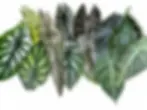
Contents:
Species Origins – The Blueprint Behind Every Dragon Alocasia
Every Dragon-named Alocasia owes its striking form to wild species from Southeast Asia. These plants evolved in specific environments — limestone outcrops, humid rainforest floors, or ultramafic soils—which explains why their hybrids demand stable humidity, chunky substrates, and warm, draft-free conditions indoors. Knowing their origins isn’t trivia — it’s the foundation for proper care.
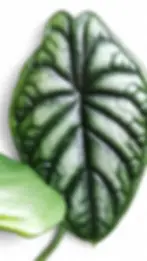
Alocasia baginda
Authority: Alocasia baginda Kurniawan & P.C.Boyce, Acta Phytotax. Geobot. 61: 123 (2011)
Native Range: Borneo
Habitat: Likely ultramafic or limestone substrates, shaded understory
Key Traits: Stiff, bullate leaves with matte dark green tone and pale interveinal zones
Role in Dragons: The genetic backbone for Dragon Scale, Silver Dragon, and Green Dragon
Care Impact: Thick leaves control water loss, but roots are highly sensitive to excess moisture → needs an airy, fast-draining aroid mix
Authority: Alocasia melo A.Hay, P.C.Boyce & K.M.Wong, Bot. Mag. 14: 84 (1997)
Native Range: Sabah, Borneo
Habitat: Ultramafic soils in open forest gaps
Key Traits: Extremely thick, stone-like foliage with blue-green tone; very short petioles
Role in Dragons: Adds rugged texture and structural density to hybrids like Dragon Moon
Care Impact: Hybrids tolerate brief dryness better but require mineral-rich substrate
Authority: Alocasia reginula A.Hay, Gard. Bull. Singapore 50: 258 (1998)
Native Range: Northern Borneo
Habitat: Humid forest floor with loose, fast-draining soils
Key Traits: Small leaves with velvety black-green surface and bright white venation
Role in Dragons: Contributes dark Source of velvety depth in hybrids like Black Dragon.pigmentation and velvet texture in Black Dragon
Care Impact: Slows growth and increases root sensitivity → hybrids need longer drying intervals and excellent aeration
Authority: Alocasia longiloba Miq., Fl. Ned. Ind. 3: 207 (1856)
Native Range: Yunnan to Peninsular Malaysia
Habitat: Ravines and riverbanks, sometimes on limestone
Key Traits: Large arrowhead-shaped leaves, silvery veins, purple undersides
Role in Dragons: Adds elongated form and bold venation (e.g., Dragon’s Tooth)
Authority: Alocasia heterophylla (C.Presl) Merr., Philipp. J. Sci., C 3: 220 (1908)
Native Range: Philippines
Habitat: Lowland forests near water
Key Traits: Narrow, spear-like leaves with a silvery wash
Role in Dragons: Adds slender elegance in Dragon’s Breath
Authority: Alocasia scalprum A.Hay, Gard. Bull. Singapore 51: 30 (1999)
Native Range: Samar Island, Philippines
Habitat: Moist understory with deep shade
Key Traits: Small species with lanceolate, falcate leaves and sharp venation
Role in Dragons: Influences hybrids like Dragon Wings with sleek leaf silhouette
Authority: Alocasia cucullata (Lour.) G.Don, Hort. Brit., ed. 3: 631 (1839); basionym: Arum cucullatum Lour.
Native Range: Naturalized and cultivated across tropical Asia
Habitat: Often near human disturbance, watersides, and temple gardens
Key Traits: Broad ovate leaves, 10–40 cm long; cultural significance as a “good-luck” plant
Role in the Dragon Context: possibly a parent to the 'Dragon Tail' and involved in trade name confusion.
‘Crinkles’: A curly-leaf mutation of A. cucullata.
Dragon Tail: Frequently marketed as separate, but likely the same as ‘Crinkles’ or a very similar mutation.
Collector Takeaways
Bullation = baginda genes → needs high humidity and loose, airy substrate
Hybrids with melo → thicker, slower leaves, slight drought tolerance
Hybrids with reginula → compact, velvety, but very root-sensitive
Size spread: Jewel types (15 cm leaves) vs longiloba-based forms (up to 80 cm)
Meet the Core Cultivars – Dragon Scale, Silver Dragon & Green Dragon
When collectors talk about “Dragon Alocasias,” they usually mean cultivars of Alocasia baginda. These plants share the armored, bullate leaf texture that made the series famous—but subtle differences in color, sheen, and growth behavior set them apart.
Why It’s Iconic: The cultivar that defined the category. Its deeply quilted surface and sharp venation give that classic dragon-like look.
Leaf Color: Deep emerald green with lighter interveinal zones for strong contrast.
Texture: Thick, leathery, and highly bullate (quilted).
Size: Leaves 30–40 cm; compact habit.
Growth Behavior: Moderate speed when humidity stays stable.
Collector Note: A reliable choice for the traditional “armored foliage” aesthetic.
What Makes It Different: Adds a frosted metallic sheen that shifts with light.
Leaf Color: Silvery-gray interveins framed by dark green veins.
Texture: Bullate, slightly smoother than Dragon Scale.
Light Impact: Brighter indirect light enhances silver contrast.
Size: Similar to Dragon Scale—30–35 cm leaves.
Growth Behavior: Slower and more sensitive to fluctuations.
Collector Note: Perfect for those who want the jewel-like silver tone.
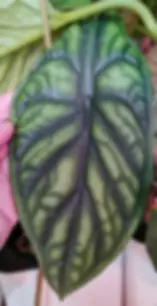
Alocasia 'Green Dragon'*
Why It Stands Out: A balanced choice for collectors—retains the armored, bullate texture of the Dragon series but with richer green tones and subtle silver feathering for depth.
Leaf Color: Deep emerald base with muted silvery highlights along interveins, creating contrast than Silver Dragon.
Texture: Firm, quilted surface typical of baginda cultivars, but slightly less pronounced than Dragon Scale.
Growth Behavior: More vigorous and adaptable than Silver Dragon, making it less prone to stress under moderate humidity fluctuations.
Collector Insight: Ideal entry point into the Dragon series for those who want classic baginda aesthetics without the slow pace or sensitivity of silver-heavy cultivars.
*Note on Dragon Scale vs. Green Dragon
There is ongoing debate among growers about whether Green Dragon is a distinct cultivar or simply Dragon Scale expressing greener tones under different conditions. Environmental factors—such as light intensity, humidity, and nutrient balance — can significantly influence color depth and metallic sheen in A. baginda types. Until there’s genetic verification, treat these names as horticultural selections rather than formally separate cultivars.
Variegated Dragons – Why They’re Collectors' Favorites
Occasional tissue-culture mutations have produced stunning variegated versions of Alocasia baginda cultivars. These aren’t just color variations — they are genetic quirks that dramatically alter growth speed and care requirements.
Appearance: Marbled white patterns splashed across deep green, bullate leaves.
Growth: Significantly slower than the standard form.
Care Impact: Needs brighter, indirect light to maintain white contrast; still avoid direct sun.
Appearance: Cool, mint-green marbling layered with subtle silver tones.
Growth: Slightly stronger than Albo, but still slow.
Care Impact: Similar light needs — brighter than standard forms for color stability.
Appearance: A dramatic golden marbling over the frosted silver base—a showpiece for any collection.
Growth: The slowest of all variegated Dragons due to reduced chlorophyll and complex pigmentation.
Care Impact: Golden variegation retains only trace chlorophyll, so photosynthesis is severely reduced — though slightly higher than in pure white areas. Expect very slow growth and high sensitivity to fluctuations. Provide bright, indirect light to support green sectors, and avoid stressing the plant with repotting or sudden changes.
What to Expect Before Buying
Variegation Stability: Patterns are not stable and unexpected, expect a lot leaf-to-leaf variation.
Light Requirements: Bright, indirect light is critical — not to increase variegation, but to prevent reversion and maintain contrast.
Bottom Line on Variegates
If patience and consistency are your strengths, variegated Dragon Alocasias are worth it. They grow slower, need careful attention, and command premium prices — but few plants match their visual impact.
Hybrids & Advanced Crosses – The Signature Dragons Explained
Not all “Dragons” are baginda cultivars. Some are true interspecific hybrids, combining traits that don’t occur naturally. These crosses change leaf texture, growth rate, and even care requirements.

Alocasia ‘Black Dragon’
Parentage: A. baginda ‘Silver Dragon’ × A. reginula (‘Black Velvet’)
Leaf Traits: Deep, almost black surface with a subtle velvety finish layered over bullate structure. Veins are muted, creating a gothic, matte look under indirect light.
Mature Size: Compact — leaves 20–30 cm long; overall plant height up to 40 cm in pots.
Growth Behavior:
Slow-growing and root-sensitive due to reginula genetics.
Requires slightly longer drying intervals than standard Dragons to prevent rot.
Performs best in stable humidity (70%+) and warm conditions (22–28 °C).
Care Challenges: Very unforgiving of overwatering; avoid dense soil mixes.
Collector Insight: Often labeled as “Segoro Biru” or “Black Maharani.” Verify ID before purchase.
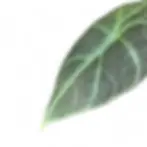
Alocasia ‘Dragon Moon’
Parentage: A. melo × A. baginda ‘Silver Dragon’
Leaf Traits: Thick, rugged, stone-like blades with silvery frost patterns. Surface texture feels sculptural and heavy, inherited from melo.
Mature Size: Medium — 30–45 cm leaves; upright growth habit.
Growth Behavior:
Slower than pure baginda cultivars but less sensitive than Black Dragon.
Can tolerate short dry intervals and slight humidity dips (down to 55%).
Care Notes: Needs strong, indirect light to maintain contrast; prefers a very chunky mix with extra mineral content (due to melo’s ultramafic-soil heritage).
Collector Insight: Still rare in trade, but increasing via tissue culture.
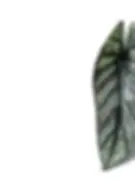
Alocasia ‘Dragon Wings’
Parentage: A. baginda ‘Dragon Scale’ × A. scalprum
Traits: Lanceolate blades with partial bullation; early observations suggest elegant elongation combined with textured depth.
Hybridizer: David Fell (2024 introduction).
Status: Extremely rare; tissue culture not yet mainstream—availability is limited.
Collector Note: Anticipated as one of the most architecturally unique Dragons for collectors seeking something beyond the jewel aesthetic.
Other Cultivars & Named Selections in the Dragon Series
Alocasia 'Pink Dragon' – A Name With Two Identities
Why the confusion?
The nickname “Pink Dragon” is widely used in the plant trade, but it doesn’t belong to just one plant. Both Alocasia ‘Aurora’ and Alocasia ‘Morocco’ are frequently sold under this name — despite being distinct in origin, appearance, and growth behavior. This mix-up traces back to the early 2000s when Aurora was introduced in Europe under the Pink Dragon label. Later, as hybrids like Morocco gained popularity for their compact form and glossy leaves, the same name was applied to them too.
Alocasia ‘Aurora’
Background: Believed to be an undescribed species or natural hybrid from Southeast Asia, first circulated via Bangkok Flower Market. Became the genetic base of the Safari Series.
Leaf Traits: Matte green with green abaxials (undersides) that may darken to burgundy in low light.
Petiole: Bright pink, usually solid without heavy streaking.
Growth: Taller and more open than Morocco — 50–60 cm in a 15 cm pot; prefers consistent humidity like other jewel Alocasias.
Alocasia ‘Morocco’ (ALO3)
Parentage: Aurora × Polly; hybridized by Marian Osiecki in 2007; patented by Oglesby Plants International (USPP25803P2).
Leaf Traits: Dark green glossy leaves with a silver shadow along veins; glossy burgundy undersides for striking contrast.
Petiole: Pale pink with green or brown streaks; thicker than Aurora’s petioles.
Growth: Compact and symmetrical — 30–35 cm in a 15 cm pot. Vigorous, stress-tolerant, and a strong basal shoot producer.
✔ Quick ID Tip:
Glossy leaves + burgundy undersides + streaked pale pink petioles = Morocco.
Matte leaves + green undersides + vibrant solid pink petioles = Aurora.
Parentage: Derived from A. heterophylla.
Leaf Traits: Slender, spear-like foliage with smoky silver tone and softly glowing veins — completely different vibe from the bullate Dragons.
Growth Notes: Faster and less root-sensitive than baginda types; tolerates medium humidity.
Collector Note: First introduced by Silver Krome Gardens; ideal for collectors who prefer elegant, elongated foliage over heavy-textured leaves.
Parentage: A. longiloba selection.
Leaf Traits: Arrowhead-shaped leaves with sharp tips, silver central veins, deep green topside, and rich purple underside. Petioles are often mottled chocolate-brown.
Growth Behavior: Faster than jewel types; can grow up to 50 cm leaves indoors with sufficient light.
Collector Insight: For those who want bold structure over compact jewel appeal.
Unknown provenance, although some say it is the same plant as A. cucullata ‘Crinkles’
Dragon Tail: Usually described as a tissue-culture chimera mutation. Leaves are long, narrow, and curl inward, creating a tail-like spiral. Upright, compact growth habit.
Crinkles (A. cucullata cultivar): Reported to have curled or twisted leaf margins, sometimes inward rather than just ruffled. This makes it visually very close to Dragon Tail in photos.
What We Know:
Many sellers use these names interchangeably, suggesting they might be identical or closely related.
No authoritative genetic confirmation exists, and no formal cultivar description for Dragon Tail has been published.
* Personally we don't think it's the same plant. 'Crinkles' has very different blade colouration (much lighter) and more 'regular' curled edges. 'Dragon Tail' leaves seem more erratic, the margin undulation is quite irregular and the leaf blades are very dark in comparison. But this is just our observation
Parentage: Believed to be A. sarian × A. new guinea gold. (not confirmed)
Leaf Traits: Semi-pinnate foliage with bright golden veins and boldly striped petioles.
Size: Massive — up to 2–2.5 m indoors. Needs strong light and ample space.
Collector Insight: Not a jewel Alocasia — best for statement interiors or greenhouse setups.
Dragon Alocasias – Complete Comparative Matrix
Name | Parentage / Type | Leaf Traits | Mature Size | Growth Speed | Care Sensitivity |
|---|---|---|---|---|---|
Dragon Scale | A. baginda cultivar | Deep green, strong bullation, armored texture | Leaves 30–40 cm | Moderate | Root-sensitive; needs 70% humidity |
Silver Dragon | A. baginda cultivar | Frosted silver overlay, dark venation | Leaves 30–35 cm | Slow | Light-sensitive; dislikes fluctuations |
Green Dragon | A. baginda cultivar | Rich green with soft metallic undertones | Leaves 30–40 cm | Faster than Silver Dragon | More forgiving than other baginda forms |
Dragon Scale Albo Variegata | A. baginda mutation | White marbling on deep green bullate leaves | Leaves 20–30 cm | Very slow | Needs bright, indirect light for contrast |
Dragon Scale Mint | A. baginda mutation | Mint-green tones with faint silver sheen | Leaves 20–30 cm | Very slow | Same as Albo; avoid stress |
Silver Dragon Aurea Variegata | A. baginda mutation | Golden marbling over frosted silver base | Leaves 20–25 cm | Ultra slow | Delicate roots; strict humidity control |
Black Dragon | Hybrid (Silver Dragon × reginula) | Almost black leaves with velvety matte finish | Leaves 20–30 cm; plant 40 cm | Very slow | Highly root-sensitive; stable humidity critical |
Dragon Moon | Hybrid (A. melo × Silver Dragon) | Rugged, stone-like texture with frosty silver overlay | Leaves 30–45 cm | Slow | Handles mild neglect better than Black Dragon |
Dragon Wings | Hybrid (Dragon Scale × scalprum) | Lanceolate blades with partial bullation | Estimated 25–40 cm leaves | Likely moderate | Requires high humidity and airflow |
Pink Dragon (Aurora) | Natural hybrid or undescribed species | Matte green leaves with bright pink petioles | Leaves 30–50 cm | Moderate | Prefers stable humidity like jewel types |
Pink Dragon (Morocco) | Hybrid (ALO3) | Glossy green tops, burgundy underside, pink petioles | Leaves 30–50 cm | Moderate | Sensitive to light shifts; check petiole ID |
Dragon’s Breath | A. heterophylla selection | Long, spear-shaped leaves with smoky silver wash | Leaves 25–35 cm | Faster than baginda types | Easier; tolerates slightly lower humidity |
Dragon’s Tooth | A. longiloba selection | Arrowhead shape, silver midrib, purple underside | Leaves 30–45 cm | Faster than jewel Alocasias | Requires bright light and space |
Dragon Tail | Likely A. cucullata mutation | Narrow, inward-curled leaves resembling a tail | Leaves 20–30 cm | Moderate | Growth stability unclear; needs warmth |
Golden Dragon | Hybrid (A. sarian × A. new guinea gold) | Semi-pinnate leaves, golden venation, striped petioles | Full plant 2–2.5 m indoors | Fast if well-fed and bright | Needs strong light, large container, heavy feeding |
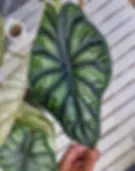
Care Essentials for Dragon Alocasias
Dragon Alocasias demand conditions that mimic their native rainforest understory: high humidity, consistent warmth, and bright, diffused light. Below is a general care framework for these jewel plants and their hybrids. For full details — including botanical background, native habitat, troubleshooting, and in-depth care—check each plant’s dedicated page in our shop.
1. Light – Bright, Indirect, and Steady
Ideal: Bright, filtered light near an east-facing window or under quality grow lights (~10,000–15,000 lux).
Avoid:
Harsh midday sun → burns leaves.
Low-light spots → stunts growth, dulls color, and reduces silver or variegation contrast.
Variegated & Silver Forms: Need extra brightness (never direct sun) to keep color stable.
Collector Tip: If leaves start turning flat green, increase brightness — not fertilizer.
💡 Struggling to define “bright, indirect light”? It’s one of the most misunderstood terms in plant care—and a critical factor for keeping your Dragon Alocasias healthy. We’ve broken it down into clear, practical guidelines with real lux values and placement tips.
2. Watering – Controlled, Not Scheduled
Rule: Water when the top 15–20% of the mix feels dry. In a 20 cm pot, that’s about 3–4 cm down.
Why: Prevents oxygen loss and fungal rot — the #1 killer of baginda types.
Hybrid nuances:
Black Dragon: Roots are extra sensitive; allow slightly longer drying intervals.
Dragon Moon: Thicker leaves tolerate short dry gaps but still hate extremes.
Avoid: Standing water in saucers, full saturation routines, or “calendar watering.”
3. Humidity – Stability Over Tricks
Target: 60–80% relative humidity.
Why: Prevents crispy edges on bullate leaves.
Best Methods:
Room humidifier for consistency.
Moderate airflow to prevent fungal issues.
Myths to Ditch: Pebble trays and daily misting do almost nothing for humidity and often cause spotting.
💡 Wondering how to keep humidity in the sweet spot for Dragons? Stable humidity is just as important as light for these jewel Alocasias. Learn practical, myth-free methods that actually work — no pebble trays, no daily misting. Mastering Humidity for Healthier Houseplants
4. Temperature – Warm, Draft-Free
Optimal: 20–28 °C (68–82 °F).
Critical Low: Below 15 °C = growth stop and root stress.
Tip: Keep away from heaters, cold glass, and AC vents — sudden fluctuations kill these plants faster than steady suboptimal light.
5. Substrate – Open, Aerated, and Moisture-Balanced
Ideal Mix:
40% fine orchid bark
20% perlite
20% coco coir
10% horticultural charcoal
10% sphagnum moss
Why: Mimics loose rainforest soils; prevents compaction while holding moderate moisture.
Advanced Option: Semi-hydro or mineral substrates work for experienced growers — but monitor nutrient flow and oxygen balance.
6. Fertilizing – Consistent, Not Seasonal
Frequency: Every 4–6 weeks during active growth.
Strength: Balanced liquid feed at 25–50% dilution (e.g., NPK 3:1:2 or 20-20-20).
Variegated Forms: Feed lightly — forcing growth can damage weaker marbled tissue.
Myth Check: “Stop feeding in winter” applies only if growth truly halts. In stable indoor setups, plants often keep growing year-round.
Want to dive deeper into feeding routines? Fertilizing isn’t just about adding nutrients — it’s about timing, dilution, and avoiding common mistakes. Explore practical, science-based tips in our dedicated series: Fertilizing Houseplants
7. Repotting – Minimal Upsizing
Only repot when roots circle the pot or mix compacts.
Increase pot size by 2–3 cm max to avoid soggy soil zones.
Thinking about upsizing your Dragon’s pot? Repotting can make or break these sensitive Alocasias. Learn when and how to do it without stressing your plant: Repotting Houseplants – A Complete Guide
8. Health Watch – Pests & Stress Signals
Common Pests: Spider mites (especially on velvety hybrids), thrips, mealybugs.
Prevention: Weekly underside checks; use neem-based soap or systemic insecticide if needed.
Struggling with spider mites or thrips? Here’s how to win that battle. All Pest Control Guides
9. Quick Troubleshooting Table
Symptom | Likely Cause |
Brown leaf edges | Low humidity or fertilizer buildup |
Yellowing leaves | Overwatering or compacted soil |
Silver fading to green | Insufficient light |
Sudden leaf collapse | Cold stress or root rot |

10. Dormancy – Reality vs Myth
True dormancy rarely occurs indoors unless temps drop below 18 °C and light declines drastically.
What looks like dormancy is often stress from cold or recent repotting.
Do not force a “dry rest.” If the plant keeps producing leaves under grow lights, keep care steady.
11. Toxicity Warning
All Dragon Alocasias contain calcium oxalate crystals — harmful to pets and humans if ingested. Sap can irritate skin — wear gloves when repotting.
12. Best Environment – Controlled Microclimates Win
Why collectors use cabinets or vitrines:
Locks in 60–80% humidity without constant humidifier use.
Maintains warmth and stable airflow (add a small fan to avoid stagnant air).
Who benefits most:
Jewel Alocasias like Silver Dragon and Black Dragon — both react strongly to fluctuations.
Variegated forms — they grow slower and are less tolerant of stress.
While these plants can survive in open rooms with consistent care, enclosed setups give a huge advantage in drier homes or during winter.
Want to dive deeper into Alocasia care beyond Dragons?
Check out our Ultimate Alocasia Care Guide for complete tips on light, watering, substrates, and troubleshooting.
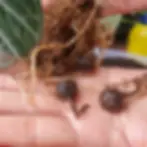
Propagation Techniques for Dragon Alocasias
Why Propagation can be tricky for Dragons
Compact Rhizomes: Baginda cultivars rarely create easy division points.
Slow Pups: Offsets are uncommon, appearing only on very mature plants.
Root Fragility: These species have delicate roots prone to rot when disturbed.
Most Reliable Method: Corm Propagation
Corms are the go-to propagation strategy for Dragon Alocasias because they naturally detach from the mother plant without major trauma.
Where to Find Corms:
Typically hidden in the substrate around the rhizome base.
Often discovered during repotting or soil refresh.
How to Propagate Corms:
Collect: Gently remove corms during repotting, ensuring no damage to the mother plant.
Clean: Rinse off old substrate and treat with a mild fungicide or cinnamon dust to prevent rot.
Pre-Sprout Setup: Place corms in moist (not wet) sphagnum moss inside a ventilated container.
Ideal Conditions:
Temperature: 24–28 °C
Humidity: 80–90% RH
Light: Low to medium indirect light — no direct sun during sprouting.
Timeframe:
Sprouting usually takes 4–8 weeks, sometimes longer for baginda types.
Transition: Once roots and a small shoot appear, transfer to a chunky aroid mix or semi-hydro setup.
Success Tip: Monitor moisture carefully — soggy moss = rot. A barely damp environment works best.
Rhizome Division – Only for Mature Plants
When: Only attempt if your plant is extremely well-established and has multiple clear growth points.
Risks: High stress; divisions often sulk for months or fail if conditions aren’t perfect.
Why Rare: Baginda types grow slowly, and dividing too early can permanently stunt the plant.
What Doesn’t Work
Leaf Cuttings: Impossible — no nodes = no plant.
Water-Only Propagation: Leads to rot before root initiation.
Petiole Cuttings: Unlike some aroids, Dragon Alocasias cannot regenerate from petiole segments.
Reality Check for Collectors
Propagation of Dragon Alocasias is a slow, patient process. Expect corm sprouting to be your main strategy — anything else is high-risk without guaranteed results. Most new plants in trade come from tissue culture, not hobbyist propagation.
Dragon Alocasia Troubleshooting Guide – Symptoms, Causes, and Fixes
Symptom | Likely Causes | Solutions |
|---|---|---|
Brown leaf edges | - Low humidity (below 50%) - Fertilizer salt buildup - Inconsistent watering | - Maintain 60–80% RH with a humidifier or enclosed cabinet - Flush soil to remove salts - Keep watering even |
Yellowing lower leaves | - Overwatering - Compacted or poorly draining soil - Root rot | - Check roots for rot; trim damaged tissue - Repot into chunky aroid mix - Adjust watering schedule |
Silver turning green | - Insufficient light - Light spectrum too warm (for grow lights) | - Increase brightness (10,000–15,000 lux) - Use full-spectrum grow light if natural light is weak |
Sudden leaf collapse | - Cold stress (below 15 °C) - Severe root rot | - Move plant to 20–28 °C zone - Remove rotting roots, repot in fresh substrate, use systemic fungicide |
Leaf curling inward | - Low humidity - Underwatering - Temperature fluctuations | - Stabilize RH at 60–80% - Water when top 15–20% of soil is dry - Keep away from drafts or AC vents |
Leaves shrinking in size | - Light deficit - Nutrient imbalance - Root restriction | - Provide brighter light - Fertilize with balanced liquid feed at 25–50% strength - Repot if rootbound |
Brown spots on leaf surface | - Fungal/bacterial infection from poor airflow - Misting habits | - Increase airflow (small fan) - Stop misting - Remove affected leaves, treat with fungicide |
Slow or stalled growth | - Low temperature - Light too weak - Nutrient deficiency | - Keep 20–28 °C range - Ensure bright indirect light - Feed monthly during active growth |
Pale or faded leaves | - Iron or magnesium deficiency - Overwatering reducing oxygen uptake | - Use a complete fertilizer with micronutrients - Improve drainage and avoid waterlogging |
Petiole rot at base | - Water sitting in crown - Poor drainage and stagnant air | - Water soil directly, avoid wetting crown - Improve substrate aeration - Add airflow in growing space |
Why Light Changes Dragon Alocasia Color
Color shifts in Dragon Alocasias aren’t magic — they’re driven by plant physiology:
Silver & Frosted Tones - These effects come from a combination of thicker cuticles and air spaces in leaf tissue that scatter light. In low light, the plant produces more chlorophyll, which masks the silver overlay and makes leaves appear greener.
Dark or Black Pigmentation (Black Dragon) - This intense color comes from high concentrations of anthocyanins in the upper epidermis. These pigments act as a natural sunscreen, protecting leaves from excess light while reducing water loss.
Pink Petioles & Vein Highlights - Caused by anthocyanins rather than chlorophyll. They persist even under slightly lower light but fade if the plant is stressed or nitrogen-heavy.
Key Takeaway:
Silver fade? It’s not genetics — it’s light deficit. Increase filtered brightness.
Variegation stability? Genetics set the pattern. Light only helps maintain contrast, not create new variegation.
Want to dive deeper into how variegation and pigments shape plant colors? Read our Guides to Variegation, Pigmentation & Leaf Color.
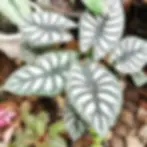
Dragon Alocasia FAQs – Your Top Questions Answered
1. Why is my Silver Dragon turning green?
This is almost always a light issue — not a fertilizer problem. When Silver Dragon receives insufficient brightness, the frosted overlay fades and leaves develop a flat green tone.
Fix: Move the plant to a brighter spot with filtered light or use a quality grow light (~10,000–15,000 lux). Avoid direct midday sun, which burns delicate tissue.
2. Do Dragon Alocasias need a winter rest period?
Not necessarily. These plants don’t go into true dormancy indoors unless temperature and light drop significantly. If your setup maintains warmth (20–28 °C) and bright indirect light, they can grow year-round.
Tip: Never “force” a dry rest. If leaves are still forming, continue regular care — scaled to growth speed.
3. Why are my Dragon Alocasia leaves curling inward?
Common causes:
Low humidity (below 50%)
Underwatering or compacted mix
Sudden temperature drops Solution: Check humidity first, then inspect soil moisture. Curling from cold stress may also follow shipping or drafts.
4. How often should I water Dragon Scale or Silver Dragon?
There is no fixed schedule. Water when the top 15–20% of the mix is dry. For a 20 cm pot, that’s about 3–4 cm deep. Always let excess drain completely — never leave water in saucers.
5. Why do new leaves emerge smaller than older ones?
Usually caused by one of three factors:
Insufficient light → weak photosynthesis
Nutrient imbalance → especially low nitrogen or micronutrients
Root restriction → plant needs repotting
Fix: Improve light, feed with a balanced liquid fertilizer (25–50% dilution), and check root space.
6. Are Dragon Alocasias pet-safe?
No. All Alocasias, including Dragons, contain calcium oxalate crystals. Ingestion can cause severe irritation in pets and humans. Sap contact may irritate skin — wear gloves when pruning or repotting.
What’s the Rarest Dragon Alocasia?
At the top of the rarity scale are variegated cultivars (e.g., Silver Dragon Aurea Variegata or Dragon Scale Albo) and new-generation hybrids like Dragon Wings. These plants often exist only in private collections or limited-release batches.
However, rarity is changing. Tissue culture (TC) is gradually making some previously unattainable Dragons more accessible, which also lowers prices over time.
💡 Tip: If you’re not in a hurry, waiting for a tissue-cultured (TC) release can save you hundreds of euros. While there’s no absolute guarantee that a specific cultivar will enter TC production, high-demand plants almost always make it into propagation eventually.
8. How do I boost variegation on Dragon Scale Albo or Mint?
Variegation is genetic. You can’t “create” it with care, but you can maintain strong contrast by:
Providing bright, indirect light (never full sun)
Avoiding excessive nitrogen, which pushes green tissue faster than white
Keeping care stable to prevent stress reversion
9. Why is my Dragon Alocasia leaf collapsing suddenly?
Two likely causes:
Cold shock (below 15 °C)
Root rot from waterlogged soil Action: Check roots immediately — healthy roots should be firm and pale. Remove damaged roots, repot into a chunky aroid mix, and stabilize temperature.
10. Can Dragon Alocasias grow in semi-hydroponic systems?
Yes, with proper monitoring. Inert substrates (e.g., LECA or mineral media) work if:
You keep consistent water levels (never let roots dry completely)
Use a complete nutrient solution and flush regularly to avoid salt buildup
Maintain high humidity to offset faster evaporation
Semi-Hydro and Dragon Alocasias – What You Should Know
Thinking about using semi‑hydro for your jewel Alocasias like Silver Dragon or Dragon Moon? This method offers stable moisture balance, fewer pests, and clearer control — but only if executed correctly. Explore our semi‑hydro guides here: Semi-Hydro
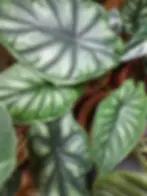
Final Thoughts – Your Complete Dragon Alocasia Reference
Dragon Alocasias aren’t just “pretty leaves”—they represent decades of selective breeding rooted in wild genetics. From the armored bullation of A. baginda to the rugged density of A. melo and the velvety sheen of A. reginula, every trait reflects adaptation to rainforest environments. This guide brings all that diversity together in one place—so you can compare species origins, identify hybrids, and choose the right cultivar for your collection. Whether you favor the iconic Dragon Scale, the shimmering Silver Dragon, or rare hybrids like Dragon Wings, success comes from precision: bright filtered light, stable humidity, and an airy, mineral-balanced substrate. Use this article as your benchmark, and let every future purchase be an informed one.
Ready to add a Dragon Alocasia to your collection?
Explore our full Alocasia lineup — from classic cultivars like Dragon Scale and Silver Dragon to rare hybrids and variegated treasures. Each plant comes with detailed care guidance and collector insights to help you succeed.
Sources and Further Reading:
The following references provide authoritative taxonomic data, ecological context, and propagation insights for Alocasia species and cultivars discussed in this guide. They include peer-reviewed studies, botanical monographs, and reputable digital herbarium resources for further exploration.
Aroid Society. (n.d.). Aroideana, Volume 7, Issue 3. Retrieved from https://www.aroid.org/aroideana/aroideana-v7n3
Aroid Society. (n.d.). Aroideana article archive. Retrieved from https://www.aroidsociety.org/aroideana/artpage.php?key=MDA3MzQwMQ==E
Aroidia Research. (n.d.). Alocasia cucullata information. Retrieved from https://aroidiaresearch.org/acucull.htm
Aroidia Research. (n.d.). Alocasia reginula information. Retrieved from https://aroidiaresearch.org/reginula.htm
Aroidpedia. (n.d.). Alocasia genus profiles and species accounts. Retrieved from https://www.aroidpedia.com/alocasia
Boyce, P. C., & Kurniawan, A. (2011). Studies on the Alocasia Schott (Araceae-Colocasieae) of Borneo II: Alocasia baginda, a new species from East Kalimantan, Indonesian Borneo. Acta Phytotaxonomica et Geobotanica, 61, 123–130. Retrieved from https://www.researchgate.net/publication/308522698_Studies_on_the_Alocasia_Schott_Araceae-Colocasieae_of_Borneo_II_Alocasia_baginda_a_new_species_from_East_Kalimantan_Indonesian_Borneo
Hay, A. (1999). The genus Alocasia (Araceae-Colocasieae) in the Philippines. The Gardens' Bulletin, Singapore, 51(4), 1–41. Singapore: Singapore Govt. Print. Off. Retrieved from https://biostor.org/reference/140161
Hay, A. (1998). The genus Alocasia (Araceae-Colocasieae) in West Malesia and Sulawesi. The Gardens' Bulletin, Singapore, 50(4), 221–334. Singapore: Singapore Govt. Print. Off. Retrieved from https://biostor.org/reference/140160
IPNI / Plants of the World Online. (n.d.). Alocasia baginda. Retrieved from https://powo.science.kew.org/taxon/urn:lsid:ipni.org:names:995487-1
IPNI / Plants of the World Online. (n.d.). Alocasia cucullata. Retrieved from https://powo.science.kew.org/taxon/urn:lsid:ipni.org:names:84151-1
IPNI / Plants of the World Online. (n.d.). Alocasia heterophylla. Retrieved from https://powo.science.kew.org/taxon/urn:lsid:ipni.org:names:1006568-1
IPNI / Plants of the World Online. (n.d.). Alocasia longiloba. Retrieved from https://powo.science.kew.org/taxon/urn:lsid:ipni12.org:names:84179-1
IPNI / Plants of the World Online. (n.d.). Alocasia reginula. Retrieved from https://powo.science.kew.org/taxon/urn:lsid:ipni.org:names:1010791-1
IPNI / Plants of the World Online. (n.d.). Alocasia scalprum. Retrieved from https://powo.science.kew.org/taxon/urn:lsid:ipni.org:names:84195-1
Philippine Alocasia Project. (n.d.). Alocasia heterophylla species profile. Retrieved from https://sites.google.com/view/philippinealocasias/species-groups/ph-species-groups/heterophylla-ph/a-heterophylla?authuser=0
Philippine Alocasia Project. (n.d.). Alocasia scalprum species profile. Retrieved from https://sites.google.com/view/philippinealocasias/species-groups/ph-species-groups/scabriuscula-ph/a-scalprum
Smithsonian National Museum of Natural History. (n.d.). Botany collection search. Retrieved from https://collections.nmnh.si.edu/search/botany/
Wong, S. Y., Hay, A., & Boyce, P. C. (1997). Studies on the Alocasia of Borneo. Retrieved from https://www.biodiversitylibrary.org/page/43578420#page/42/mode/1up
Yusuf, M., et al. (2023). In vitro propagation of Alocasia baginda ‘Silver Dragon’ through direct and indirect organogenesis. Retrieved from https://www.researchgate.net/publication/381947962_In_vitro_Propagation_of_Alocasia_baginda_%27Silver_Dragon%27_through_Direct_and_Indirect_Organogenesis













